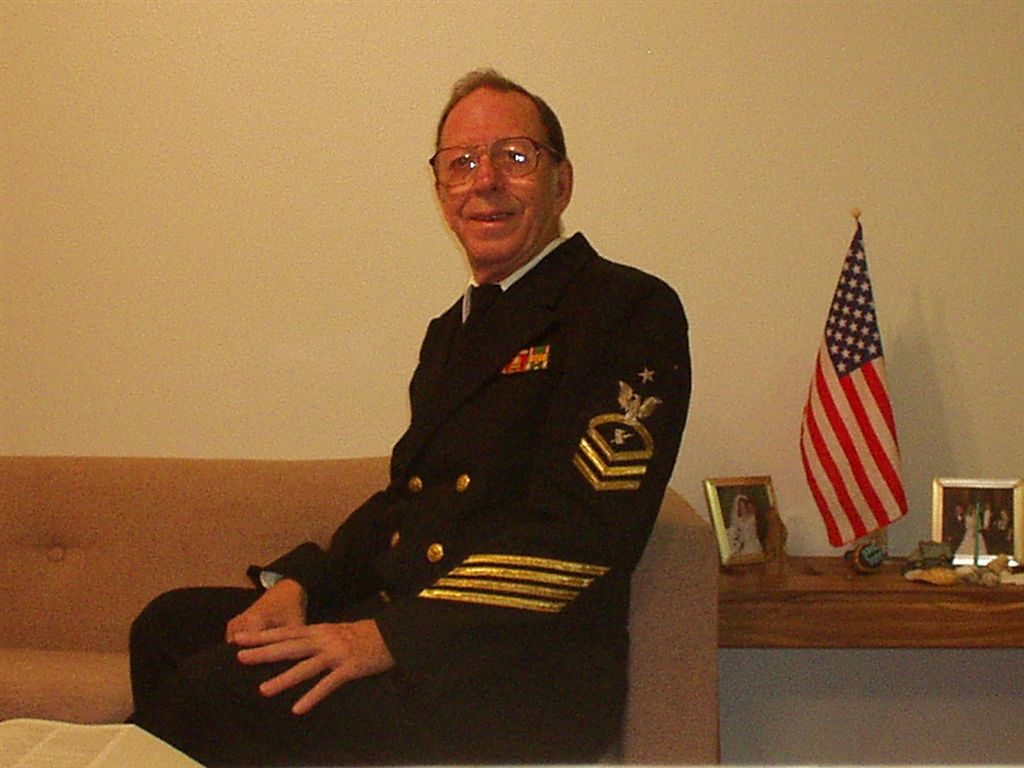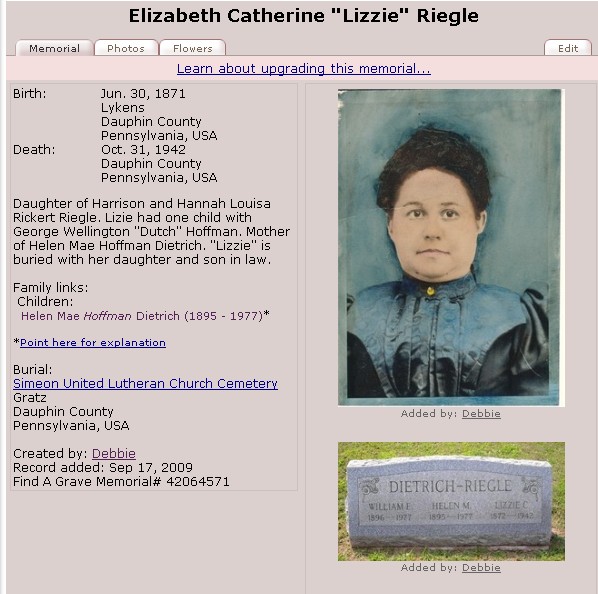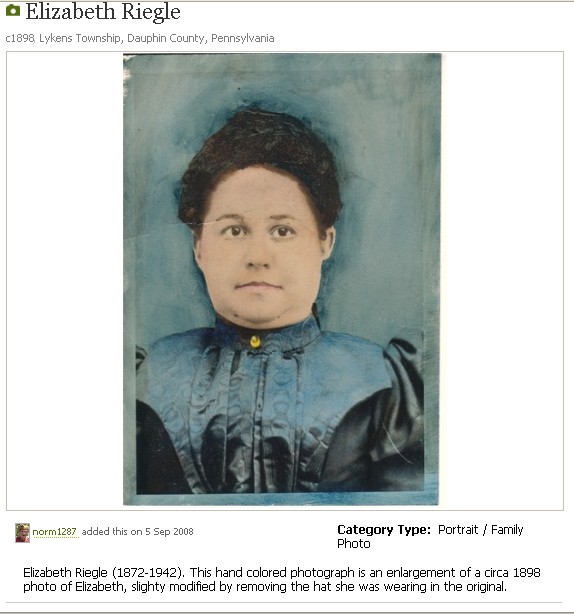The Fair Use Doctrine and Pictures Found on Find A Grave
Posted By Norman Gasbarro on March 3, 2011
In the first post about the Find A Grave site, a statement was made about those contributors to the site who are very proactive about warning people who use the site about theft of their photographs. The understanding of these individual is that any one who uses a photograph of theirs, under any conditions and without their express written permission is violating U.S. copyright law. They are presenting what they believe to be an accurate interpretation of the law. Apparently, they are not aware of the “Fair Use Doctrine.”
The “Fair Use Doctrine” is found in Title 17, Section 107 of the United States Code, “Limitations on Exclusive Rights.” It states that:
Notwithstanding the provisions of sections 106 and 106A, the fair use of a copyrighted work, including such use by reproduction in copies or phonorecords or by any other means specified by that section, for purposes such as criticism, comment, news reporting, teaching (including multiple copies for classroom use) scholarship, or research, is not an infringement of copyright. In determiing whether the use made of a work in any particular case is a fair use the factors to be considered shall include —
(1) the purpose and character of the use, including whether such use is of a commercial nature or is for nonprofit educational purposes;
(2) the nature of the copyrighted work;
(3) the amount and substiantiality of the portion used in relation to the copyrighted work as a whole; and
(4) the effect of the use upon the potential market for or value of the copyrighted work.
The following is not a legal argument and doesn’t purport to be. It’s more of a common sense look at this little known part of U.S. copyright law (Section 107) and what a layman might understand it to be.
Theft of someone’s work is a violation of the law. When someone steals your work, they are claiming credit for its creation, and they either profit from the theft in some way and/or they financially harm the person who created the work. The onus is on the person who created the work to prove that they created it, that it was stolen from them, and that they were harmed by the theft. Usually, this takes the form of legal action against the purported thief which is initiated by the person who claims that he or she has been harmed. In most cases, this involves hiring an attorney, filing papers in a court of law, and then following through with costly litigation. Thus, it is the court that determines whether there is a violation of copyright, not the individual making the accusation; the accused is entitled to due process.
If I downloaded a picture from the Find A Grave web site and then re-posted the picture on another site and claimed I took the picture (or owned the rights to it), I believe that I would be violating the copyright laws. Under academic rules and procedures, this would be called plagiarism. Under most circumstances, the claim that a work is your own when in fact it was produced or created by someone else, is a violation of the copyright laws. If I violated the copyright laws, it would still be up to the individual who believes I violated the copyright law to prove it in a court of law.
But, would I be violating the copyright laws if I posted a Find A Grave picture on another site as part of a criticism or review of the Find a Grave site – and I indicated that the picture was not mine, but was from the Find A Grave site? Would I be violating the copyright laws if I posted the picture on another site as part of a not-for-profit educational study to find out more about the individual represented in the picture – and I indicated clearly that the picture was from the Find A Grave site?
The answer to the first question is most likely “no.” Criticism and review is a permitted use under Title 17, Section 107 of the United States Code.
Although the answer to the second question is not as clear, the “factors to be considered” come into play. – and that’s where the policies of the Find A Grave site come into play – and, to some extent, the statements made by the persons who claim to be the owners of the pictures in question as well as the nature of the site itself.
The Find A Grave site as a whole claims that more than 57 million graves are registered, that written and pictorial memorials are posted, and genealogical and historical information is made readily available to those who visit the site. New memorials are posted each day. Volunteers contribute their time to maintaining the records (or memorials) and upload information. Find A Grave does not claim to own the information or pictures presented. The persons submitting information and pictures are not required to indicate the sources of the information or pictures. All Find A Grave memorials require information, but a supplementary (or optional) component is the grave marker photo. Few, if any of the 57 million records contain original information, created or discovered for the first time by the individual doing the posting. Information is often copied from the grave marker and is publicly available in cemetery lists or on the stones themselves. The pictures, where provided, are for the most part not unique in that they are simple camera shots of grave markers – grave markers that are publicly displayed in public cemeteries. One hundred pictures of grave stone taken at different times will essentially look the same (showing little uniqueness) and will be difficult to distinguish from each other. A picture is never posted without basic information. And, the information and the picture make up the memorial.
Find A Grave provides space for contributors to post a biographic sketch about themselves. It is in the biographical sketches that the contributors make statements about the use of their work. The fact that each contributor is permitted to express his/her own interpretation of the copyright laws, or present “rules” for the use of what is claimed to be copyrighted works, helps to create the confusion about what is permitted and what is not permitted.
I will refer to one contributor to the Find A Grave web site and quote his profile statement. The volunteer is known as GulfportBob and he has been submitting information and pictures for nearly five years:
I add interments when I find them, if they are from your family, I want to transfer them to you because you have more information than I do.
If you are maintaining a section of military information elsewhere, I want you to maintain the memorial sites too. Again you have more info than I do.
All my photos are freely available to all persons to use in a respectful manner.
I am 71 years old. I have retired from the United States Navy.I only use my electric bicycle and public transportation. I am living at the Armed Forces Retirement Home, Gulfport, Mississippi. And am currently in Thailand and will photographing in this area.
I am also happy to say that I have photographed every grave site at the US Soldiers’ and Airmen’s Home National Cemetery and the Battleground National Cemetery both in Washington, D.C.I have also Posted every grave site at St. Elizabeth’s Hospital (West Campus).

GulfportBob
Gulfport Bob is an example of the finest of the contributors to Find A Grave. He has contributed nearly 17,000 photos for which he is not asking for money – and he is granting permission for anyone to use his photos in a respectful manner. A “respectful manner” would include not claiming the photos as your own when you use them – and attributing them to the Find A Grave site where anyone seeking the complete information as to the source can easily find it. GulfportBob posted the grave picture of the Civil War soldier John Saltzer who died during the Civil War and was buried in the Soldiers and Sailors Cemetery (see post from two days ago).
Examples of those who do not give permission for re-posting of their photos can easily be found. They are often the whiners and “experts” on the copyright laws who have been mentioned in these postings. Sometimes they disrespectfully “brand” their pictures with their e-mail addresses or copyright notices and warnings. I will not single out any of them in this post.
The next example is from a specific Find A Grave memorial:
The picture was posted, apparently contrary to Find A Grave rules, without permission from “the owner of the copyright.” The original digital photograph of the hand colored photograph can found on the Ancestry.com site:
I created the above hand colored photograph from an enlargement of a pre-1898 photo. It was created in the late 1970s. There is only one copy of this original work and it is hanging on my wall in my home. The picture is of my great-grandmother “Lizzie” Riegle” who I never met. I also have hand colored pictures of “Lizzie’s” parents – Harrison Riegle, a Civil War veteran from Lykens Township, Dauphin County, Pennsylvania and Hannah [Rickert] Riegle – also unique and also hanging on a wall in my home. According to the rules of the Ancestry.com site, anyone can add the above picture to their family tree (it was posted as a public picture) and the credit is retained with the picture. However, there is no indication on the Ancestry.com site that anyone from Ancestry.com has added this picture to their tree. The picture of “Lizzie” was added to the Find A Grave memorial with the source not indicated and when it was added, the person who added it did not indicate that he/she had permission to re-post it or publish it. Likewise with the grave marker photo – also similar to the one taken by me in the Gratz Union Cemetery and also posted on Ancestry.com.
The point I want to make about all this is that I have no objection to the use of my work although I have not implicitly stated that in the Ancestry.com posting. When I posted the picture on Ancestry.com, I assumed that at some point someone would “lift” (steal) it and use it as their own. What recourse do I have? I can ask the poster to remove it, but what good would that do? I can hire an attorney and file suit against the person or the site (at my expense), but I would have to prove I have suffered a loss. It’s only a digital scan of an original work. And, how much have I lost by having the picture posted on Find A Grave? Probably nothing. Likewise with the picture of the grave marker. The picture is either the same one that I took – or one so similar that it would be difficult to distinguish mine from the one posted on Find A Grave. Someone who wants to post a memorial to my great-grandmother can do so – so long as there is accurate information in the memorial about her.
Find A Grave cannot police all the volunteers and contributors on its site, nor can it check on every picture posted on its site.
By calling a posting a “memorial” and having that memorial consist of information and a picture, re-posting of a Find A Grave picture is the re-posting of a part of a memorial. And if someone claims to have posted hundreds or thousands of pictures as part of their total work and the pictures in themselves are not unique and they have done so as a volunteer, the re-posting of one or even hundreds of non-unique pictures (out of 57 million total memorials) seems to fall within the “fair use doctrine” of the U.S. copyright laws – provided, of course, that the attribution or credit is given to the “total work,” which is the site, Find A Grave – and the re-posting is done to further knowledge and for non-profit purposes. And, since Find A Grave cannot guarantee that the poster of the material holds the “copyright” on the material, the re-poster need only cite the Find A Grave site as the origin of the material. If material were posted on a site owned by an individual and the material were said to be copyrighted or created by an individual, then the interpretation of the law might be different.
The Internet has created all sorts of situations with copyright that were not previously imaginable. The very nature of the Internet is that it is a free an open exchange of information and ideas. Copies of copies of copies can fly through cyberspace in an instant. If someone has taken a photograph and posts it on a site on the Internet, they should expect that someone else will use it. While they should expect that anyone using it will attribute it to the site where it was taken from, they should understand that once it is posted, they lose control of their work. My “copyrighted” digital picture of a hand colored picture of my great-grandmother can now be attributed to Find A Grave – or to the person who posted it, rather than to me, the person who created it. I understood that by posting it.
Most genealogical publishing is done as a labor of love with no profit intended or expected. The writers and researchers of family history need to be able to “quote” material and cite sources. Scholarship and research cannot be hindered by narrow interpretations of copyright laws. In a democratic society, the “Fair Use Doctrine” protects scholars and researchers, promotes the exchange of ideas, and leads to new discoveries.
Simple advise: (1) Post only what you want others to use. (2) If you re-post, attribute the item to the place where you found it. (3) Be sure that the re-post falls under the “factors to be considered” clauses of Section 107 of the U.S. copyright laws.
As a registry of grave sites, Find A Grave is an excellent resource for genealogical research. Most of its volunteers understand that once their material is uploaded, they could lose control over ownership of that material. “Fair Use” permits researchers to use or “quote” from whatever is upload to the Find A Grave site and “rules” of citation, require the researcher to cite the source from which he/she got the material. The site managers at Find A Grave should ask their volunteer contributors to remove the threatening, inappropriate, and inaccurate comments from the biographical profiles and they should inform them of the “Fair Use Doctrine” as well as the realities of the Internet.
Comments and suggestions are welcomed.
 ;
;




This was very helpful and sensible!
There are very few instances where republishing a photo would qualify under the Fair Use exception. You hit one on the head: critique. Another one is thumbnails that direct you back to the original location (see Kelly v. Arriba).
However, the terms of use (TOS) of the sites you use need to be followed. Nearly all sites prohibit republishing material that violates the intellectual property rights of others. Ancestry does:
“No Ancestry member or visitor to the website may: Post, transmit, or display content which is protected by copyright or trademark or that does not belong to you and that you do not have authorization for use from the owner of the copyright or trademark, including but not limited to email messages and notes in GEDCOMs. Read our copyright policy for more information.”
No doubt the hosting service you use for this blog has a similar statement.
The example of the photo of your great grandmother is a “derivative work” and therefore you cannot claim originality. However, the grave marker photo is obviously yours even though cropped. You asked “What recourse do I have?” No need to hire an attorney. You simply write to Find A Grave and ask for it to be removed, providing a link to your original on Ancestry showing the date of upload preceded the date of upload on Find A Grave. They will remove it because the contributor violated their policy.
Ancestry’s Community Guidelines state “Any information you post in our community is public and can be copied, modified and distributed by others.” That does not limit others use to only Ancestry or only saved from the original location. Understanding this difference is important. By adding content to Ancestry, you are giving everyone permission to use it, any place, in any manner they choose, according to those guidelines.
On the other hand, Find A Grave does not have such a public-use policy. Find A Grave policy requires asking permission to use photos.
Find A Grave’s administration understands the “Fair Use” exception to copyright protection remarkably well and are not going to misinform their contributors republishing on other sites is okay.